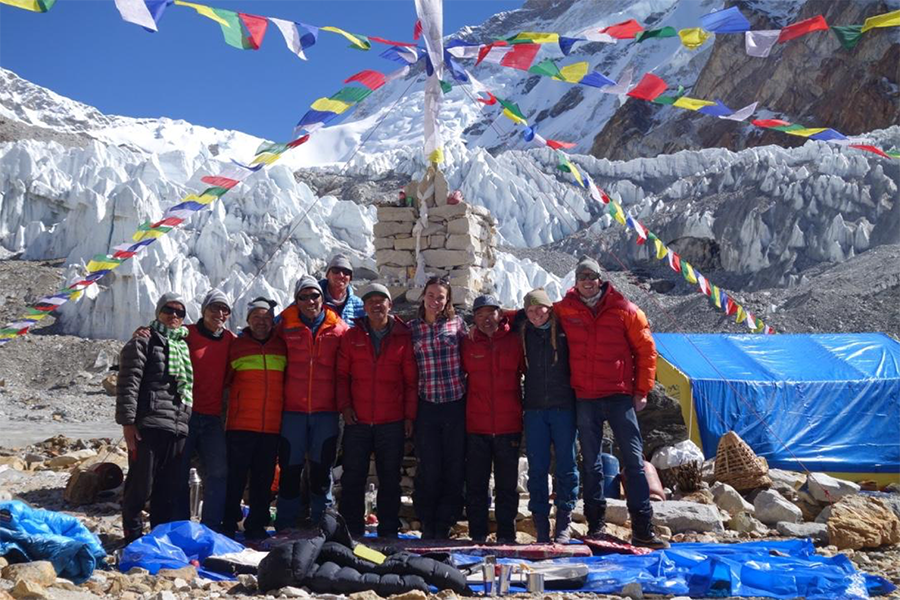As a certified IFMGA/AMGA mountain guide and founder/CEO of Alpenglow Expeditions, I’ve led more than 100 international climbing expeditions on five continents, including six successful summits of Mt. Everest. Along the way, I’ve learned valuable lessons about leadership.
A climb is always a team effort. And, though the physical challenges are daunting, the key factor in achieving your goal is how well your team collaborates.
On the mountain, strategic decisions can literally be life-saving. Makalu is considered one of the world’s most difficult climbs. Our team – four professional athletes and four Sherpas – was attempting to become the first to ski from its summit. It was here, hovelled in our Camp 4 tent, just one day away from our goal, that our team faced one of the climb’s biggest challenges: team disagreement.
Earlier in the day, one of our climbers had been caught in a minor avalanche, luckily only bruising ribs during his fall. Still, he was injured and was incapable of shouldering his share of the team’s carefully designed load.
Now it was time for the team to make a decision. Our options were straightforward: continue pushing upwards in clearly dangerous conditions with one man down, end the expedition and try to descend safely, or retreat to Base Camp and hope for another summit window in the upcoming weeks.
It had taken us three years of planning, six weeks of trekking, and four long days of backbreaking work in deep snow and high winds to reach 26,000 feet. Some of us wanted to continue; others thought it best to turn back. After some initial discussion, it became clear our team of eight could not agree on one option. Whether the avalanche hazard would reduce in the next few days was the main point of debate – along with different personal feelings on whether individuals had the physical energy to attempt the summit.
At almost 26,000 feet, rational discussion is made much more difficult by the lack of oxygen. Each of us were displaying symptoms of altitude sickness – splitting headaches, deep exhaustion, and constant nausea. As expedition leader, it was my job to manage the team towards a decision we all could live with, and then execute on it. But how?
Here’s the system I employed to get our team back on track and focused on a goal that would best suit the organization as a whole.
- Revisit the team’s mutual goals and their order of priority.
In our case – (1) we wanted every member of the team to return home safely; (2) we wanted to leave the mountain as clean and untouched as we had found it; (3) we wanted as many members as possible to summit the peak; and (4) we wanted as many members as possible to ski from the peak. Revisiting our goals and the order of their priority helped us, as individuals, set aside our own personal goals and biases, and focus on the team’s goals. - Give each team member the time to express their individual feelings and opinions.
Despite the extreme situation we were in, it was essential to take time to hear from everyone. We spent two hours after the avalanche discussing options, and then again another two hours the next morning – allowing ourselves “to sleep on it.” During this time, each team member – from the most experienced to the least – played a part in the discussion. - Respect each member’s opinion, even when you don’t agree.
As the most experienced on the team (I have summited Everest six times and spent 20 years climbing in the Himalayas), I had my own strong opinions. But, to have buy-in from the team in a decision this controversial, it was essential I and everyone truly listened and tried to understand each member’s opinions. - Be strong, make the decision, and stick with it.
After four hours of debate, it was clear our team was not going to come to a unanimous decision. But, through the act of group discussion, my opinion had been changed and clarified. While I personally wanted to stay and climb – to meet our team’s goals in order of their importance – the right decision was to descend and to clean the mountain. An upcoming storm made the chance of a later summit window unlikely, and the storm also meant it was likely any gear we left on the mountain would be destroyed and lost – essentially left as trash. With our discussions at a stalemate, I thanked everyone for all of their effort through the difficult conversations, announced my decision, and laid out a plan to quickly and safely get us off the mountain before the storm began.
A month later, our team got together just to debrief the trip and begin to dream up ideas for the next expedition. We stayed friends and colleagues, and can’t wait for our next adventure together. So, while our trip failed to achieve two of its goals, it also succeeded at two. And we have become a stronger team through the process – more ready for the next challenge.
For more information, visit www.alpenglowexpeditions.com.
 Adrian Ballinger is a certified IFMGA/AMGA mountain guide and founder/CEO of Alpenglow Expeditions.
Adrian Ballinger is a certified IFMGA/AMGA mountain guide and founder/CEO of Alpenglow Expeditions.

